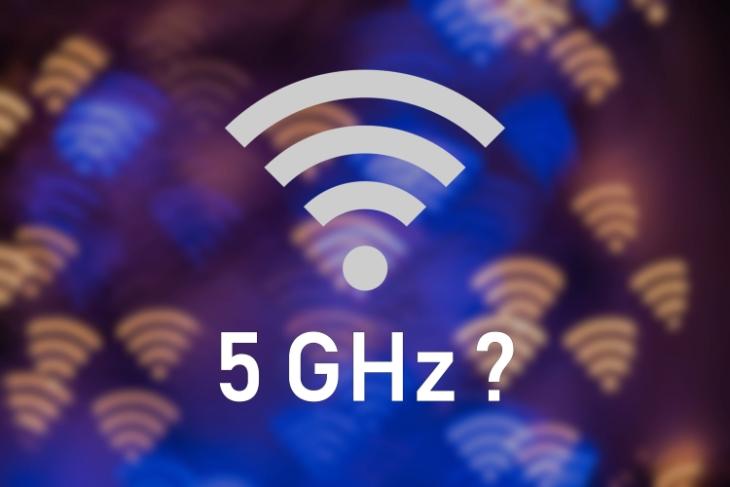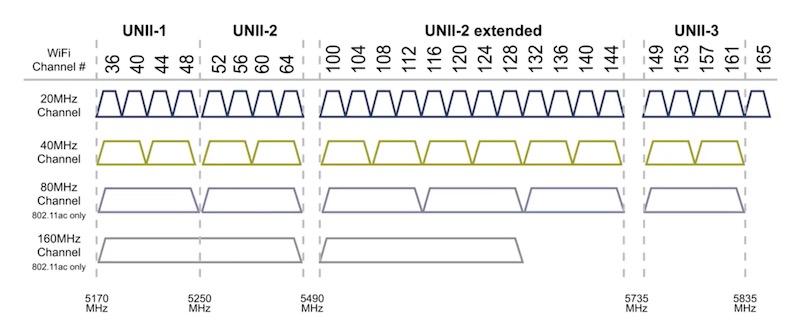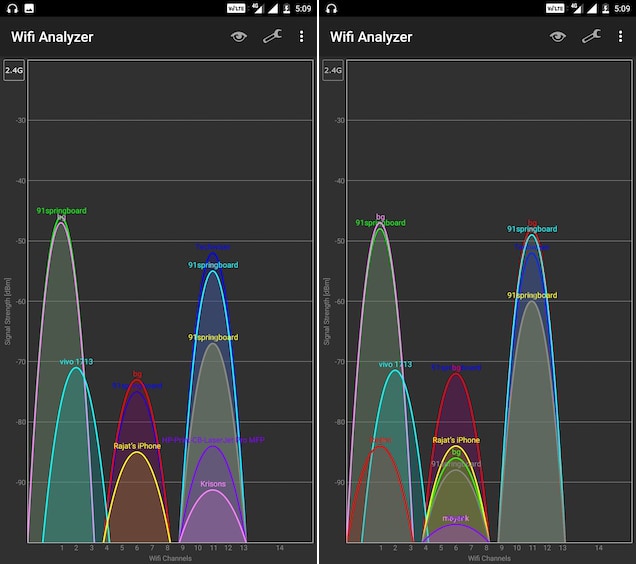How To Transfer Data From Old Phone To Moto G5s Plus

Nosotros all use WiFi at our homes and offices and virtually of u.s. are familiar with the moniker two.4 GHz and 5 GHz frequency bands. In fact, all the connected devices that we buy today including our smartphones, tablets, and more, mention as to which frequency bands they support. That said, not many people know the difference betwixt these frequency bands and that has led to a lot of defoliation. Well, we volition try to eradicate that confusion in this article equally we explicate everything that y'all need to know virtually the 5 GHz network to run across what makes it different from the 2.4 GHz and is information technology any better:
Understanding WiFi
Before nosotros become to sympathize the 5 GHz network, start, nosotros have to empathize how WiFi works. Just like mobile networks, WiFi networks use radio waves to transfer data beyond the network. While radio waves encompass a big frequency range (~iii KHz to 300 GHz), the master frequency range used for commercial WiFi purposes are the ii.iv GHz (ii.iv to 2.5 GHz) band and 5 GHz (5.180 GHz to v.825 GHz) band. When the get-go WiFi bands were made available for public use, an organization called IEEE (The Institute of Electrical and Electronics Engineers) set up a new committee called the "IEEE 802" which released a set up of standards chosen the "802.eleven" for implementing wireless local expanse network (WLAN) computer communication in the 2.4 and 5 GHz frequency bands.

That's why, when you come across the WLAN certification on your device, it reads 802.11 followed by whatever or all of the following letters; a/b/g/north/air-conditioning. Don't get confused by the letters as they simply signify the next standard in WLAN engineering. The 802.11 was the offset standard that was followed past the 802.11a which was followed by the 802.11b, and so on. That said these letters practise propose every bit to which frequency band your device tin can operate in. The 802.eleven b/g/n devices can receive signals that are transmitted using the 2.iv GHz band while the 802.11 a/northward/air-conditioning uses v GHz band.
What is five GHz WiFi Network?
Now that yous accept a little background knowledge of the origins of WiFi, you are ready to understand the five GHz WiFi network. As it is credible from the above department, the five GHz WiFi network uses radio waves between the frequency of 5.180 GHz and v.825 GHz. For your device to be able to receive these signals, information technology should be certified past the WLAN 802.11 a/n/air-conditioning standard. The 5 GHz ring is farther divided into 24 different channels each being 20 MHz wide. Channels are very important every bit at whatsoever given fourth dimension, your device can only use one channel, but more than on that later on . Now let's see if and why 5 GHz network is improve than the 2.4 GHz network.

five GHz vs 2.4 GHz Network
Both the 5 GHz network and the 2.4 GHz network come with their own pros and cons. Depending on the circumstances, sometimes using the two.4 GHz network will exist beneficial for you lot and vice versa. That said, in general using the v GHz network will yield a faster network speed, notwithstanding, non for the reasons you lot might call back. People who don't know about the network transfer protocols might assume that the speed on 5 GHz network will be faster as information technology has a higher frequency, nevertheless, that cannot exist farther from the truth.
-
Bug with 2.4 GHz Network
The main reason 2.4 GHz network is slower is considering of two chief reasons; channels and bandwidth. As a rule of pollex, the 802.eleven RF modulation techniques crave about xx MHz in channel width to operate. Since the 2.four GHz band has 13 channels which are only v MHz apart, there is pregnant overlap and interference between the channels. Also, the fact that ii.4 GHz channel is non but used by WiFi networks but also other types of networks such as Bluetooth, security camera, and even microwave, the two.iv GHz band is already likewise crowded and has just a express bandwidth to offer.

Due to the above two reasons, the 2.4 GHz band suffers a lot of interference. The touch on of this interference can cause anything between lower information speeds to a complete point loss depending on the nature and severity of interference. I don't desire to bore yous with the technical stuff, and then the thing that you should know is that RF channels are a shared medium. So, all the devices using the same aqueduct as your admission point will be using the same bandwidth. Seeing how 2.4 GHz network is the used past almost every smart device, that bandwidth is low to begin with. Add that to the fact that in the ii.4 GHz ring, the channels overlap with each other, which causes the devices which are not even in your aqueduct to use the same bandwidth which in turn also impedes your network.

-
How 5 GHz Network Solves These Problems?
The problems that you experience while using a 2.4 GHz network doesn't exist in the v GHz network, as information technology's non used as much as the former. This means that 5 GHz network all the same has a lot of gratuitous bandwidth which is not being exploited. It too helps that aqueduct width in 5 GHz network is twenty MHz, and hence, none of the channels overlap with each other. Because of these ii reasons, the 5 GHz network is not decumbent to the issues faced by the 2.iv GHz network.
-
Problems with 5 GHz Network
Although the 5 GHz network doesn't suffer from the same problems that we accept discussed till now, information technology has its own fair share of problems. The biggest trouble of using a 5 GHz network is that it cannot travel far and is easily impeded by structures such as walls, doors, and other physical hurdles around it. What that ways is that for getting the best speed possible, you should be direct in the line-of-sight of your router. That'due south why if you are using a unmarried router in your home, and your room doesn't accept its own router, the signal that you lot receive in your room will be far weaker on a v GHz network than what you would become if you are using the ii.4 GHz network.

Devices Compatible With v GHz Network
Every bit you can see, although 5 GHz network suffers from a few problems itself, its pros far outweigh its cons. If you want your devices to get the all-time internet speed in the futurity, you lot should just buy the ones which support v GHz WiFi Network. We have attached the list of all the phones released in the past two years which support v GHz WiFi Network to assistance you find out if your device supports it or not:
| Brand Proper noun | Model Name |
|---|---|
| Apple | iPhone X |
| Apple | iPhone eight Plus |
| Apple tree | iPhone viii |
| Apple | iPhone 7 |
| Apple tree | iPhone 7 Plus |
| Samsung | Milky way A3 (2017) |
| Samsung | Galaxy A3 (2018) |
| Samsung | Milky way A5 (2017) |
| Samsung | Galaxy A5 (2018) |
| Samsung | Galaxy S8 |
| Samsung | Galaxy S8 Plus |
| Samsung | Galaxy S7 |
| Samsung | Galaxy S7 Edge |
| Samsung | Galaxy C7 Pro |
| Samsung | Galaxy Notation 7 |
| Samsung | Galaxy Note 8 |
| Samsung | Milky way S6 Agile |
| Samsung | Galaxy S7 Active |
| Nokia | X6 |
| Nokia | 7 plus |
| Nokia | viii |
| Nokia | viii Sirocco |
| Xiaomi | Mi MIX 2S |
| Xiaomi | Mi MIX two |
| Xiaomi | Mi 8 |
| Xiaomi | Mi 7 |
| Xiaomi | Mi 8 SE |
| Xiaomi | Mi 8 Explorer Edition |
| Xiaomi | Black Shark |
| Xiaomi | Redmi Notation five Pro |
| Xiaomi | Mi A1 |
| Xiaomi | Redmi 4 Prime |
| Xiaomi | Mi Max |
| Xiaomi | Mi Max two |
| Xiaomi | Mi Max 3 |
| Xiaomi | Mi 6X (Mi A2) |
| OnePlus | OnePlus 6 |
| OnePlus | OnePlus iii |
| OnePlus | OnePlus 3T |
| OnePlus | OnePlus 5T |
| OnePlus | OnePlus v |
| HTC | HTC ten |
| HTC | HTC U12+ |
| HTC | HTC Want ten Pro |
| HTC | U Ultra |
| HTC | U11 |
| HTC | U11 life |
| Huawei | Mate 9 |
| Huawei | Mate 9 Pro |
| Huawei | Honor Magic |
| Huawei | Huawei P10 Plus |
| Huawei | Huawei P10 |
| Huawei | Huawei P20 Pro |
| Huawei | Huawei P20 |
| Huawei | Honour View 10 |
| Huawei | Huawei Honor 10 |
| Huawei | Huawei Honor Play |
| Pixel 2 | |
| Pixel 2 Xl | |
| Pixel | |
| Pixel XL | |
| Vivo | vivo V9 |
| Vivo | vivo NEX S |
| Vivo | vivo X21 |
| Vivo | vivo X21 UD |
| Vivo | vivo X20 |
| Vivo | vivo X20 UD |
| Oppo | Oppo Detect 10 |
| Oppo | Oppo F7 |
| Oppo | Oppo A83 |
| Oppo | Oppo R15 |
| Oppo | Oppo R15 Pro |
| Oppo | Oppo R9 Plus |
| Oppo | Oppo R9s Plus |
| Oppo | Oppo A5 |
| Oppo | Oppo F7 |
| Motorola | Moto G6 Plus |
| Motorola | Moto G6 |
| Motorola | Moto Z |
| Motorola | Moto Z3 Play |
| Motorola | Moto Z2 Play |
| Motorola | Moto Z Strength |
| Motorola | Moto Z2 Play |
| Motorola | Moto Z2 Force |
| Motorola | Moto G5S Plus |
| Motorola | Moto G5 Plus |
| Lenovo | Lenovo Z5 |
| Lenovo | Lenovo P2 |
| Lenovo | Lenovo ZUK Z2 |
| Lenovo | Lenovo ZUK Z1 |
| Lenovo | Lenovo ZUK Z2 Pro |
| Lenovo | Lenovo Phab2 Plus |
| Lenovo | Lenovo Phab2 Pro |
| Lenovo | Lenovo Vibe K4 Notation |
| Asus | ZenFone 3 Max ZC553KL |
| Asus | ZenFone 3 Deluxe ZS550KL |
| Asus | ZenFone 3 Ultra ZU680KL |
| Asus | ZenFone 3 |
| Asus | ZenFone 3 Max |
| Asus | ZenFone Pegasus 3 |
| Asus | ZenFone Max (2016) |
| Asus | Zenfone 5z ZS620KL |
| Asus | Zenfone 3 Zoom ZE553KL |
| LG | G7 ThinQ |
| LG | LG G6 |
| LG | V30 |
| LG | V35 ThinQ |
| LG | V30S ThinQ |
| LG | Q Stylo 4 |
| Sony | Xperia XZ2 Premium |
| Sony | Xperia XZ Premium |
| Sony | Xperia XZ |
| Sony | Xperia XZ2 |
| Sony | XZ2 Compact |
| Sony | Xperia XA2 Ultra |
| Sony | Xperia XA1 |
| Sony | Xperia XA1 Ultra |
| Sony | Xperia XA2 |
| BlackBerry | KEY2 |
| BlackBerry | Keyone |
| BlackBerry | DTEK60 |
| BlackBerry | DTEK50 |
| ZTE | nubia Red Magic |
| ZTE | nubia Z18 mini |
| ZTE | Axon 7 |
| ZTE | nubia Z18 |
| ZTE | nubia M2 |
| ZTE | nubia Z17 |
| ZTE | nubia Z17s |
| ZTE | nubia Z17 mini |
| ZTE | Nubia Z11 mini |
| ZTE | nubia Z11 mini Southward |
| Lava | Z91 |
| Lava | Z90 |
| Lava | Z80 |
Meet ALSO:Dual-Frequency GPS vs Single-Frequency GPS: What'south the Difference?
5 GHz WiFi Network: Revolution or Evolution?
5 GHz WiFi network is nothing new. In fact, it was ratified in the September of 1999 along with the 2.four GHz network. That said, since the deployment of two.4 GHz network was easier and cost-effective, it quickly became the universally adopted WiFi network while the five GHz band took a backseat. Now that the two.4 GHz frequency band is overused and is causing a lot of connectedness problems, people are turning towards the 5 GHz network which has been sitting empty for about two decades. To conclude, the 5 GHz network is goose egg revolutionary, however, it is something that we need to prefer if we are to solve our WiFi connectivity problems.
I hope that I was able to explain the 5 GHz WiFi network in a style that was understandable. Practise keep in mind that I take simplified some of the technical topics to make this commodity more reader friendly. If y'all notwithstanding cannot grasp this or have any doubts, enquire your questions in the comments section below and I will try my best to answer them every bit shortly as possible.
How To Transfer Data From Old Phone To Moto G5s Plus,
Source: https://beebom.com/what-is-5ghz-network-devices-compatible/
Posted by: eskewbece1940.blogspot.com


0 Response to "How To Transfer Data From Old Phone To Moto G5s Plus"
Post a Comment